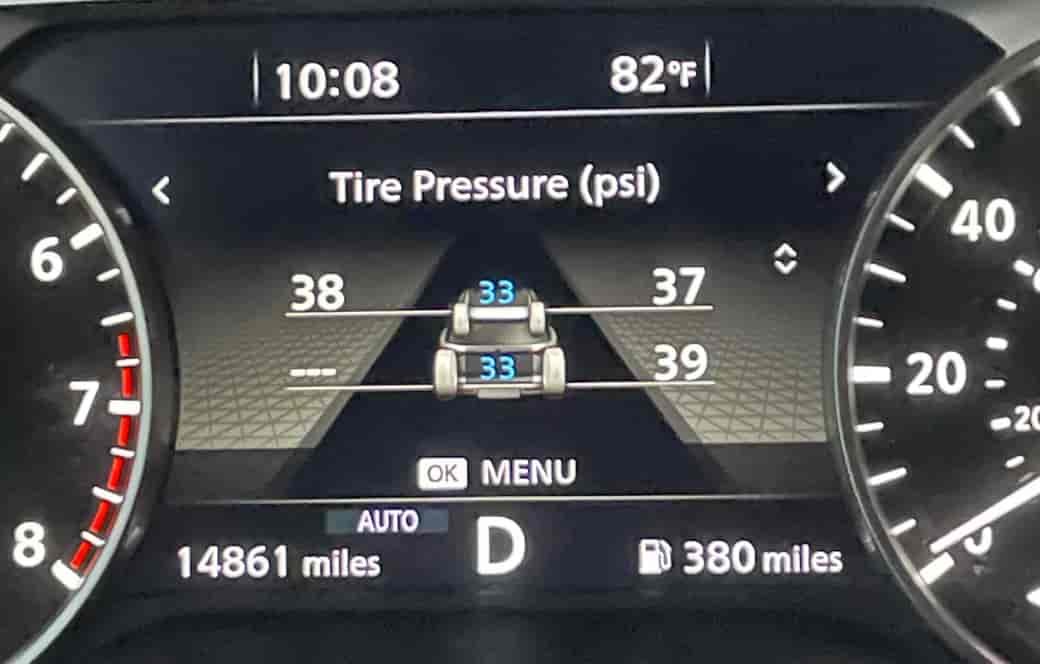Maintaining the correct Nissan Altima tire air pressure is one of the simplest yet most effective ways to keep your car safe, smooth, and fuel efficient. Many Altima owners overlook how much tire pressure affects ride comfort, handling, and even gas mileage. An underinflated tire can cause uneven wear and sluggish performance, while too much pressure makes the car feel harsh and unstable on the road.
If your tire pressure warning light comes on or your Altima feels different while driving, it is often a sign that the air pressure is not balanced. Checking your PSI regularly ensures your tires last longer and your vehicle performs the way it was designed to. This guide covers the recommended tire air pressure for every Nissan Altima model year, explains how weather changes can affect PSI, and gives you simple steps to measure and reset pressure correctly. By following these guidelines, you can keep your Altima running smoothly and safely in every season.
Recommended Tire Air Pressure by Model and Year
Every Nissan Altima model comes with a specific tire air pressure level that keeps the car stable and efficient. The ideal PSI may vary slightly depending on the year, tire size, and trim level. You can always find this information on the driver-side door jamb label or inside your owner’s manual.
Below is a general guideline for the recommended Nissan Altima tire air pressure based on model year:
For 2010 to 2015 Altima: Front tires 33 PSI and rear tires 33 PSI
For 2016 to 2020 Altima: Front tires 35 PSI and rear tires 33 PSI
For 2021 to 2025 Altima: Front tires 35 PSI and rear tires 35 PSI
These values apply to standard tire sizes. If your Altima uses larger wheels such as 18 or 19 inches, you might need to increase the pressure by 1 to 2 PSI for optimal stability. Always check the tire sidewall or owner’s manual before adjusting.
Maintaining correct tire air pressure not only protects your tires from premature wear but also improves steering response and braking performance. Consistent PSI levels help the suspension work properly and reduce fuel consumption on long trips. Regularly checking the tire air pressure once every two weeks is an easy habit that keeps your Nissan Altima safe and efficient on any road.
Tire Air Pressure by Season: Hot vs Cold Weather
The tire air pressure in your Nissan Altima changes with the temperature around you. Air expands when it is hot and contracts when it is cold, which means your PSI can increase or drop even if you have not driven the car for days. A general rule is that tire pressure decreases by about one PSI for every ten degrees Fahrenheit drop in temperature. This is why your tire pressure warning light often turns on in the winter even though you have not lost any air.
During colder months, it is a good idea to add two or three PSI above the standard recommendation to balance the loss caused by the cold air. In warmer weather, the opposite happens. If your tires are overinflated in summer, the extra heat from the road can push the PSI even higher, making the ride rough and increasing the risk of uneven wear.
To keep your Nissan Altima tire air pressure consistent, check your tires early in the morning when they are cool. Avoid checking after long drives because heat from friction can give a false reading. If you live in an area with large temperature changes, check the PSI every week instead of waiting for the warning light. Seasonal tire maintenance ensures that your Altima handles smoothly, brakes predictably, and saves fuel no matter what the weather brings.
How to Check and Reset Nissan Altima Tire Air Pressure
Checking and adjusting your Nissan Altima tire air pressure is quick and easy once you know the proper steps. Keeping your PSI balanced helps prevent uneven wear and ensures your car performs exactly as it should. You can do this at home or at a gas station using a simple tire gauge and air compressor.
Step 1: Park the car on a level surface
Make sure your Altima is parked on flat ground and that the tires are cold. Checking pressure right after driving can give inaccurate results because heat temporarily increases PSI.
Step 2: Find the recommended PSI
Look at the sticker inside the driver’s door or check your owner’s manual. This number is the ideal air pressure for your specific Altima model and tire size.
Step 3: Measure the current tire pressure
Remove the valve cap and press the tire gauge onto the valve stem. Read the PSI on the display or dial. Repeat this for all four tires, as pressures often vary slightly.
Step 4: Inflate or deflate as needed
If the PSI is too low, add air slowly and recheck. If it is too high, press the valve stem to release air until you reach the correct level. Take your time to balance all tires evenly.
Step 5: Reset the TPMS light if needed
After adjusting pressure, the Tire Pressure Monitoring System light may stay on for a few minutes. If it does not turn off automatically, drive at least ten minutes above 20 miles per hour. For newer Altima models, you can also use the vehicle settings menu on the dashboard to manually reset the TPMS.
Regularly following these steps keeps your Nissan Altima tire air pressure accurate and your car ready for any trip. It takes only a few minutes but can save you from costly tire damage and improve your overall driving safety.
Common Tire Pressure Issues and Fixes
Even when you regularly check your Nissan Altima tire air pressure, certain issues can still appear over time. Understanding these problems helps you take quick action before they affect your safety or tire life.
One of the most common issues is the tire pressure warning light staying on even after you have adjusted your PSI. This can happen if one or more tires are still slightly underinflated, or if the TPMS sensor is slow to update. The best approach is to drive for a few minutes to let the system recalibrate. If the light remains on, check each tire again or visit a service center to inspect the sensors.
Another problem is uneven tire wear. When the front tires have lower pressure than the rear ones, your Altima may pull to one side or feel unstable while braking. Keeping all tires balanced within the correct PSI range solves this easily.
Slow air leaks are also a frequent issue, often caused by small punctures or worn valve stems. A simple way to detect them is by applying soapy water to the valve area and looking for bubbles. Replacing a damaged valve stem or patching a small puncture can quickly restore proper pressure.
If you notice vibrations or a soft, spongy feeling when driving, stop and check your tire pressure immediately. Correcting minor PSI imbalances early prevents expensive repairs and keeps your Nissan Altima driving smoothly and safely every day.
Expert Tips for Maintaining Optimal Tire Pressure
Maintaining the right Nissan Altima tire air pressure is not only about adding air when the light turns on. It is about creating a simple routine that keeps your car performing at its best every day. Here are some expert tips that can help you keep your tire pressure steady, accurate, and reliable.
Always check your tire pressure when the tires are cold. When you drive, friction heats the air inside and raises the PSI, giving you an inaccurate reading. The best time to measure is in the morning before your first trip of the day.
Never inflate your tires to the maximum PSI printed on the sidewall. That number represents the highest safe limit for the tire itself, not the correct level for your Altima. Always follow the recommended PSI from the sticker on the driver’s door or the owner’s manual.
If you have recently changed tire size or wheel type, adjust the PSI according to the new setup. Larger wheels usually need slightly higher pressure for proper support and stability. Keep a digital tire gauge in your glove compartment and check the pressure at least every two weeks.
Finally, remember that balanced tire air pressure improves steering precision, braking response, and fuel economy. Making this a consistent habit ensures your Nissan Altima runs smoothly, saves gas, and stays safe on the road through every season.
Conclusion
Keeping the correct Nissan Altima tire air pressure may seem like a small detail, but it makes a major difference in how your car drives and how long your tires last. Proper PSI helps your vehicle stay balanced, improves fuel economy, and gives you a smoother, quieter ride. It also reduces the risk of blowouts and uneven wear, saving you both time and money in the long run.
Checking your tire pressure regularly takes only a few minutes, yet it ensures every trip feels safer and more comfortable. Remember to monitor the PSI more often during temperature changes, use a reliable tire gauge, and follow the recommended pressure listed on your car’s door label.
If you have not checked your Nissan Altima tire air pressure recently, now is the perfect time to do it. A simple adjustment today can prevent future issues and keep your Altima performing at its best. What PSI settings have worked best for your model and driving style? Share your experience and help other Altima owners maintain their vehicles safely and efficiently.

